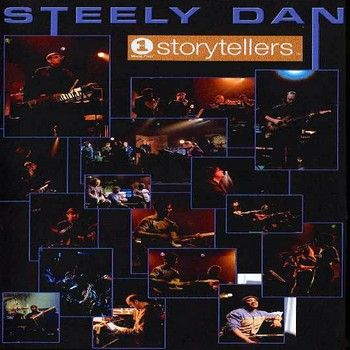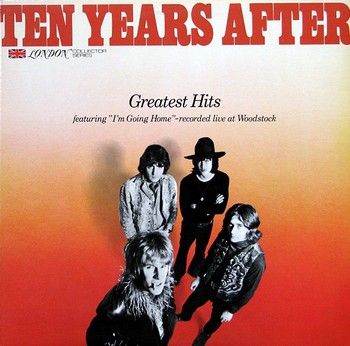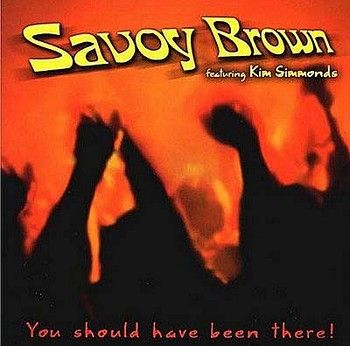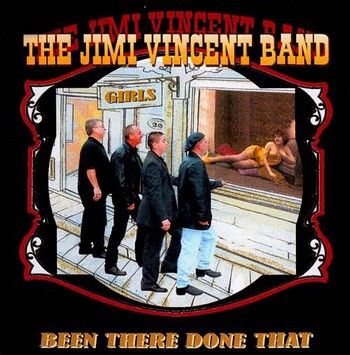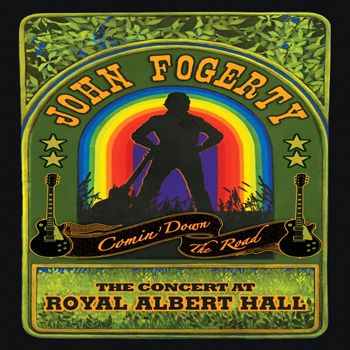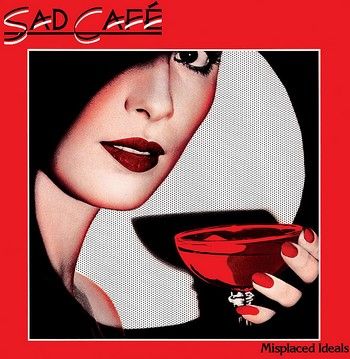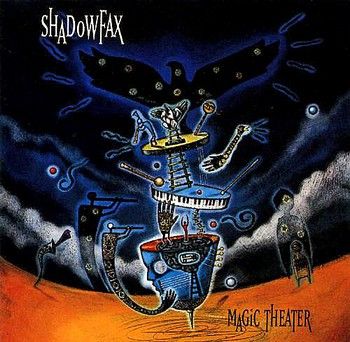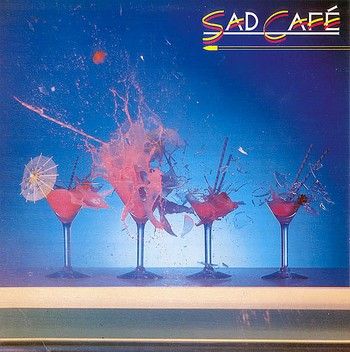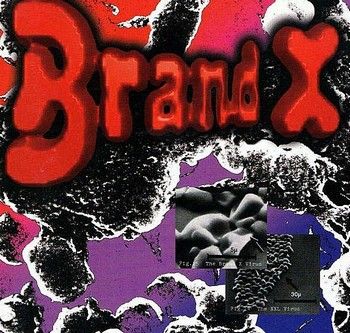
David Byrne - Live From Austin TX - 2007 - New West Records, Inc.
David Byrne is a man of many musical faces, but he's also a show biz pro, and while he's followed a number of musical paths over the course of his solo career, in concert he's shrewd enough to know he needs to give his audience (or at least a large portion of them) what they came to see — namely, the songs he helped write while he was in Talking Heads. On Live from Austin, Texas, an album drawn from a set Byrne played on the PBS music series Austin City Limits in the fall of 2001, demonstrates how he can have his cake and eat it too — while five of the thirteen tunes here come from his tenure with Talking Heads (and one is drawn from The Catherine Wheel, a solo project recorded while he was still with the band), he's reconfigured them to lean towards his fascination with world music while still holding on to the melodic structures folks remember him for. Roughly half the songs on Live from Austin, Texas also feature a string section including members of Tosca String Quartet, who add a fresh set of tonal colors to "This Must Be the Place (Naïve Melody)" and "Life During Wartime," though the ensemble really gets their chance to shine on "The Revolution" (from Look into the Eyeball, the album Byrne was promoting at the time). While he sounds a shade more enthusiastic on his more recent solo material than the relative oldies in this set, overall he seems to be in a slightly subdued mood, though he rallies for his finale, a cover of Whitney Houston's "I Wanna Dance with Somebody" that's far more sincere (and effective) than you'd imagine. In all, Live from Austin, Texas isn't the crackling live showcase you might hope for from David Byrne, though he never sounds less than professional and his head is always in the game even if his heart may be somewhere else. [A DVD of the show was also released.] © Mark Deming, allmusic.com, http://www.allmusic.com/cg/amg.dll?p=amg&sql=10:anftxzr5ldde
A great album from a rock/new wave legend. One of the great musicians and composers of modern times, the great Scot, David Byrne has been at the forefront of The Arts for many years now. He has been responsible for some of the greatest music of the last thirty or so years, and his ingenuity knows no bounds. Best known as a member of the hugely successful Talking Heads band, he has also released many great solo and collaborative works. Listen to the classic Talking Heads "More Songs About Buildings and Food " album, and the "My Life in the Bush of Ghosts" album with Brian Eno. David's "Uh-Oh" album is another great work. In truth, the guy has never made a dud album. It is also worthwhile listening to any of the Tom Tom Club's albums. Check out David's "Unplugged + More" album @
DBYRN/UNPL+MTRACKS / COMPOSERS1."(Nothing But) Flowers"- David Byrne/Chris Frantz/Jerry Harrison/Martina Weymouth
2."God's Child (Come Dance with Me)"- David Byrne
3."And She Was"- David Byrne/Chris Frantz/Jerry Harrison/Martina Weymouth
4."Once in a Lifetime"- David Byrne/Chris Frantz/Jerry Harrison/Martina Weymouth
5."The Great Intoxication"- David Byrne
6."Marching Through the Wilderness"- David Byrne/Johnny Pacheco
7."The Revolution"- David Byrne
8."This Must Be the Place (Naive Melody)"- David Byrne/Chris Frantz/Jerry Harrison/Martina Weymouth
9."What a Day That Was"- David Byrne
10."Desconocido Soy"- David Byrne
11."Like Humans Do"- David Byrne
12."Life During Wartime"- David Byrne/Chris Frantz/Jerry Harrison/Martina Weymouth
13."I Wanna Dance with Somebody (Who Loves Me)"- George Merrill/Shannon Rubicam
MUSICIANSDavid Byrne – Vocals, Guitar
Paul Frazier – Bass Guitar, Vocals
David Hilliard – Drums
Mauro Refosco – Percussion, Programming,Mallets
Leigh Mahoney, Lara Hicks, Jamie Desautels – Violin
Stephanie Ames Asbell – Viola, Vocals
Ben Westney, Sara Nelson – Cello
BIOAlthough best known for his groundbreaking tenure fronting the new wave group Talking Heads, David Byrne also received acclaim for his adventurous solo career, encroaching upon such diverse media as world music, filmmaking, and performance art in the process. Born in Dumbarton, Scotland, on May 14, 1952, Byrne was raised in Baltimore, MD. The son of an electronics engineer, he played guitar in a series of teenage bands before attending the prestigious Rhode Island School of Design, where, feeling alienated from the largely upper-class student population, he dropped out after one year. However, he remained in the Providence area, performing solo on a ukulele before forming the Artistics (also known as the Autistics) with fellow students Chris Frantz and Tina Weymouth. After changing the name of the band to Talking Heads and enlisting onetime Modern Lover Jerry Harrison, the group signed to Sire Records. A series of LPs, including the debut Talking Heads '77, 1978's More Songs About Buildings and Food, and 1980's Remain in Light followed, establishing the quartet as one of contemporary music's most visionary talents. During a band sabbatical in 1981, Byrne teamed up with Brian Eno, the producer of much of the Heads' work, for the collaborative effort My Life in the Bush of Ghosts, a complex, evocative album that fused electronic music with Third World percussion and hypnotic vocal effects. That same year, Byrne also began exploring theater with the composition of The Complete Score From the Broadway Production of "The Catherine Wheel," a dance piece choreographed by Twyla Tharp. Byrne's next solo work appeared in 1985 with The Knee Plays, a New Orleans brass band-influenced project composed for a portion of Robert Wilson's theatrical epic CIVIL warS. In 1986, Byrne wrote, starred in, and directed the feature film True Stories, a series of comic vignettes based on press clippings culled from tabloid publications like the Weekly World News. He also wrote and produced the majority of music for the film's score in addition to performing his usual duties for that year's Talking Heads LP, also named True Stories. In 1988, he wrote the score to the Jonathan Demme comedy Married to the Mob and, in tandem with Ryuichi Sakamoto and Cong Su, won an Academy Award for his musical work on Bernardo Bertolucci's historical epic The Last Emperor. Also in 1988, Byrne's fascination with world music — a longtime influence on his herky-jerky performance style as well as Talking Heads' complex polyrhythms — inspired him to form his own record label, Luaka Bop, to give widespread American release to global music. That same year, the Heads released Naked, their final proper LP, leaving Byrne to give his full attention to solo endeavors. He resurfaced in 1989 with Rei Momo, a song collection inspired by Latin rhythms, and also directed the documentary Ile Aiye (The House of Life), which focused on the rituals of Yoruban dance music. In 1991, he again collaborated with Robert Wilson on The Forest, writing music for a full orchestra. 1992's Uh-Oh marked Byrne's return to more conventional rock performance, a direction he continued with a self-titled album issued in 1994. Feelings, recorded with members of Morcheeba and Devo, followed in 1997. Four years later, Look into the Eyeball was issued on Virgin Records/Luaka Bop and captured Byrne's signature wry humor and musical diversity. In 2003, Byrne's music for the film Young Adam (featuring members of Belle & Sebastian and Mogwai) was released as Lead Us Not into Temptation by Thrill Jockey. Grown Backwards, his first disc for the Nonesuch label, appeared a year later. In 2007, the ever-busy Byrne released a CD/DVD version of The Knee Plays that featured the 12 original tracks along with eight demos and outtakes. Big Love: Hymnal, containing material composed for the HBO series Big Love, appeared in 2008; Everything That Happens Will Happen Today, a collaboration with Brian Eno that took in folk and gospel influences, followed later that year. David Byrne's next project proved to be another collaborative album, this one created with the assistance of British DJ Fatboy Slim. Released in early 2010, Here Lies Love was a concept album about former First Lady of the Philippines Imelda Marcos and her controversial love life. Over 20 guest vocalists appeared on the eclectic record, including Cyndi Lauper, Martha Wainwright, Sharon Jones, and Santigold. © Jason Ankeny, allmusic.com, © http://www.allmusic.com/cg/amg.dll?p=amg&sql=11:difqxqw5ldfe~T1
BIO (Wikipedia)David Byrne (born May 14, 1952, in Dumbarton, Scotland) is a Scottish-American musician and artist. He is perhaps best known as a founding member and the principal songwriter of the new wave band Talking Heads, who were active between 1974 and 1991. Since then, Byrne has released his own solo projects on record, and worked in a variety of media, including film, photography, opera, and internet-based projects. His achievements have been recognized by Grammy, Oscar and Golden Globe awards. He currently lives in New York City. David is a SubGenii. Byrne was born in Dumbarton, Scotland, on May 14, 1952. Two years later, his parents moved to Hamilton, Ontario, Canada, and then to Arbutus, Maryland, when he was 8 or 9 years old. He graduated from Lansdowne High School in southwest Baltimore County. He then attended the Rhode Island School of Design for one year before dropping out and forming Talking Heads in 1974 with fellow RISD students Chris Frantz and Tina Weymouth, later joined by Jerry Harrison. He also attended the Maryland Institute College of Art in Baltimore, Maryland, for one year.During his time in the band, Byrne took on outside projects, collaborating with Brian Eno in 1981 on the album My Life in the Bush of Ghosts, which attracted considerable critical acclaim and featured a groundbreaking use of sampling. Byrne has a daughter, Malu Abeni Valentine Byrne, with Adelle Lutz. Byrne and Lutz divorced in 2004. In 1981, Byrne partnered with choreographer Twyla Tharp, scoring "The Catherine Wheel," a ballet prominently featuring unusual rhythms and lyrics. Productions of "The Catherine Wheel" appeared on Broadway that same year. In Spite of Wishing and Wanting is a soundscape David Byrne produced for the Belgian dance company Ultima Vez. His work has been extensively used in movie soundtracks, most notably in collaboration with Ryuichi Sakamoto and Cong Su on Bernardo Bertolucci's The Last Emperor, which won an Oscar for Best Original Score. In 2004, Lead Us Not Into Temptation (music from the film "Young Adam") included tracks and musical experiments from his score to Young Adam. Byrne also directed and starred in True Stories, a musical collage of quirky Americana released in 1986, as well as directing the documentary Île Aiye and the concert film of his 1992 Latin-tinged tour titled Between the Teeth. He was chiefly responsible for the stage design and choreography of Stop Making Sense in 1984. Byrne wrote the Dirty Dozen Brass Band-inspired score for Robert Wilson's Opera The Knee Plays from The CIVIL warS. Some of the music from Byrne's orchestral album The Forest was originally used in a Wilson-directed theatre piece with the same name. The Forest premiered at the Theater der Freien Volksbuhne, Berlin in 1988. It received its New York premiere in December 1988 at BAM, the Brooklyn Academy of Music. The Forestry Maxi-single contained dance and industrial remixes of pieces from The Forest by Jack Dangers, Rudy Tambala, and Anthony Capel. Byrne also appeared as a guest vocalist/guitarist for 10,000 Maniacs during their MTV Unplugged concert, though the songs in which he is featured were cut from its album. One of them, "Let the Mystery Be", appeared as the fourth track on 10,000 Maniacs' cd single "Few and Far Between". Byrne also worked with "Queen of Tex-Mex", Tejano superstar Diva Selena, writing, producing and singing a song ("God's Child (Baila Conmigo)"), included on Selena's last album, "Dreaming of You", before Selena's death. Byrne was the host of "Sessions at West 54th" during its second of three seasons. Byrne founded Luaka Bop, a world music record label which releases the work of artists Cornershop, Os Mutantes, Los De Abajo, Jim White, Zap Mama, Tom Zé, Los Amigos Invisibles and others. Byrne is also a visual artist, and has shown his work in contemporary art galleries and museums around the world since the 1990s. He has also created a number of public art installations, many of them anonymous. He is represented by Pace/MacGill Gallery, NYC. In 2001 a censored version of Byrne's single "Like Humans Do" was selected by Microsoft as the sample music for Windows XP to demonstrate Windows Media Player (not included in SP2 installs).. The next year, he provided vocals for a track, "Lazy" by X-Press 2, which reached number 2 in the United Kingdom and number 1 on the U.S. Dance Charts. David said in an interview in BBC Four Sessions's coverage of his Union Chapel performance that Lazy was number 1 in Syria. In April 2003, Byrne appeared as himself in an episode of The Simpsons, "Dude, Where's My Ranch?". In late 2003, Byrne released a book with a companion DVD called Envisioning Emotional Epistemological Information (ISBN 3-88243-907-6). The work included artwork composed entirely in Microsoft PowerPoint. It includes one image that depicts, according to Byrne, "Dan Rather's profile. Expanded to the nth degree. Taken to infinity. Overlaid on the back of Patrick Stewart's head." Byrne's latest solo album, Grown Backwards, was released on March 16th, 2004 by Nonesuch. This album used orchestral string arrangements, and includes two operatic arias. He also launched a North American and Australian tour with the Tosca Strings. This tour ended with Los Angeles, San Diego and New York shows in August 2005. The following year, his singing was featured on "The Heart's a Lonely Hunter" on The Cosmic Game by Thievery Corporation. In 2005, Byrne initiated his own internet radio station, Radio David Byrne. Each month, Byrne posts a playlist of music he likes, linked by themes or genres. Byrne's playlists have included African Popular Music; Rednecks, Racists, & Reactionaries: Country Classics; Vox Humana; Classical Opera; Italian Movie Music. Byrne also posts personal comments on the music and, occasionally, on the state of the recorded music industry. In July 2007, Byrne posted the following comment: "There was another piece in the Times today about yet another 20 percent drop in CD sales. (Are they running the same news piece every 4 months?) Jeez guys, the writing's on the wall. How long do the record execs think they'll have those offices and nice parking spaces? (Well, more than half of all record A&R and other execs are gone already, so there should be plenty of parking space). They, the big 4 or 5, should give the catalogues back to the artists or their heirs as a gesture before they close the office doors, as they sure don't know how to sell music anymore. (I have Talking Heads stuff on the shelf that I can't get Warner to release.) The "industry" had a nice 50-year ride, but it's time to move on. Luckily, music remains more or less unaffected — there is a lot of great music out there. A new model will emerge that includes rather than sues its own customers, that realizes that music is not a product in the sense of being a thing — it's closer to fashion, in that for music fans it tells them and their friends who they are, what they feel passionately about and to some extent what makes life fun and interesting. It's about a sense of community — a song ties a whole invisible disparate community together. It's not about selling the (often) shattered plastic case CDs used to come in". Returning to this work in the theatre, in late 2005 Byrne and Fatboy Slim began work on Here Lies Love, a disco opera or song cycle about the life of Imelda Marcos, the controversial former First Lady of the Philippines. Some music from this piece was debuted at Adelaide Festival of Arts in Australia in February 2006 and the following year at Carnegie Hall on February 3rd, 2007. Byrne and Eno's influential 1981 album My Life in the Bush of Ghosts was re-released for its 25th anniversary in early 2006, with new bonus tracks. In keeping with the spirit of the original album, two of the songs' component tracks were released under Creative Commons licenses and a remix contest site was launched. Later that same year, Byrne released Arboretum, a sketchbook facsimile of his Tree Drawings, published by McSweeney's. He also had an exhibition of his chairs — drawings, photographs, sculptures, and embroideries — at Pace/MacGill Gallery, NYC. Byrne was profiled in the New York Times in January, 2007. The article refers to his April 15, 2006 journal entry, in which he wrote: “I was a peculiar young man — borderline Asperger's, I would guess.” It was recently announced that David Byrne is working with Brian Eno on new music. In April 2008 Byrne took part in the Paul Simon retrospective concert series at BAM performing You Can Call Me Al and I Know What I Know from Simon's Graceland album. In 2008, Byrne and his band programmed the Battery Maritime Building, a 99-year-old ferry terminal in Manhattan, to play music.
